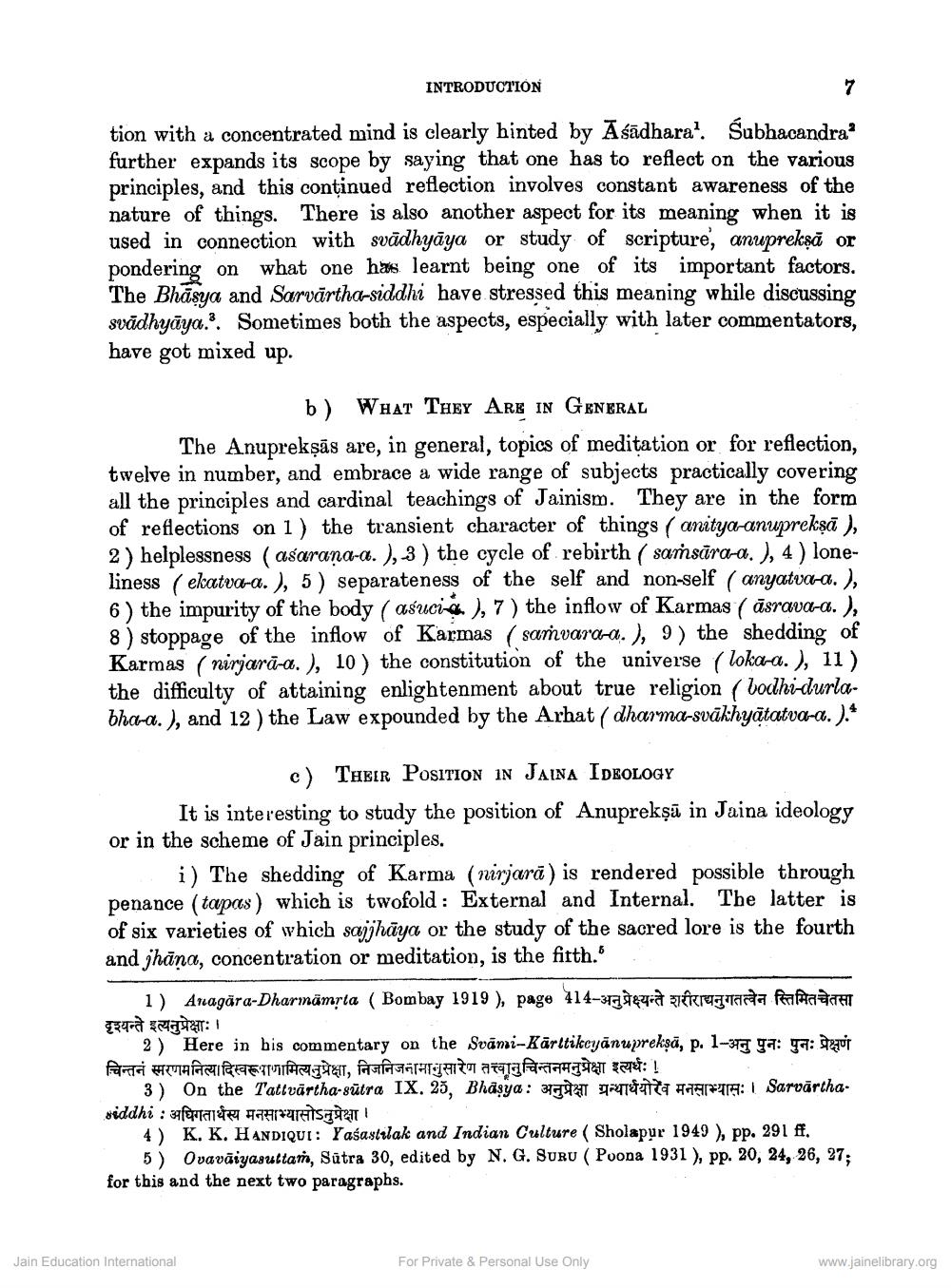________________
INTRODUCTION
tion with a concentrated mind is clearly hinted by Asadharal. Subhacandra” further expands its scope by saying that one has to reflect on the various principles, and this continued reflection involves constant awareness of the nature of things. There is also another aspect for its meaning when it is used in connection with svādhyāya or study of scripture, anupreksă or pondering on what one has learnt being one of its important factors. The Bhäsya and Sarvärtha-siddhi have stressed this meaning while discussing svādhyāya. Sometimes both the aspects, especially with later commentators, have got mixed up.
b) What They ARE IN GENERAL The Anuprekşās are, in general, topics of meditation or for reflection, twelve in number, and embrace a wide range of subjects practically covering all the principles and cardinal teachings of Jainism. They are in the form of reflections on 1) the transient character of things ( anitya-anuprekşā ), 2) helplessness (asarana-a. ), 3) the cycle of rebirth ( samsāra-a. ), 4) loneliness ekatva-a. ), 5) separateness of the self and non-self ( anyatva-a. ), 6) the impurity of the body ( asucia), 7) the inflow of Karmas (āsrava-a. ), 8) stoppage of the inflow of Karmas (sarvara-a. ), 9 ) the shedding of Karmas (nirjarā-a.), 10 ) the constitution of the universe ( loka-a. ), 11 ) the difficulty of attaining enlightenment about true religion (bodhi-durlabhaa.), and 12 ) the Law expounded by the Arhat ( dharma-svākhyātatva-a.).*
c) THEIR POSITION IN JAINA IDEOLOGY It is interesting to study the position of Anuprekşā in Jaina ideology or in the scheme of Jain principles.
i) The shedding of Karma (nirjarā) is rendered possible through penance (tapas) which is twofold : External and Internal. The latter is of six varieties of which sajjhāya or the study of the sacred lore is the fourth and jhāna, concentration or meditation, is the fitth.
1) Anagara-Dharmāmsta (Bombay 1919 ), page 414-31ed kranar a fonte दृश्यन्ते इत्यनुप्रेक्षाः।
2) Here in bis commentary on the Svāmi-Kārltikcyānuprekşā, p. 1-3 ga: ga tamor चिन्तनं स्मरणमनित्यादिस्वरूपाणामित्यनुप्रेक्षा, निजनिजनामानुसारेण तत्त्वानुचिन्तनमनुप्रेक्षा इत्यर्थः !
3) On the Tattvārtha-sūtra IX. 25, Bhâsya: 316H 7 HAFTA: Sarvārthasriddhi : 5 fra Trasha
4) K. K. HANDIQUI: Yaśastelak and Indian Culture ( Sholapur 1949), pp. 291 ff.
5) Ovavāiyasuttar, Sūtra 30, edited by N. G. SURU (Poona 1931 ), pp. 20, 24, 26, 27; for this and the next two paragraphs.
Jain Education International
For Private & Personal Use Only
www.jainelibrary.org




